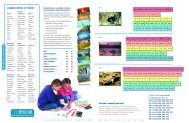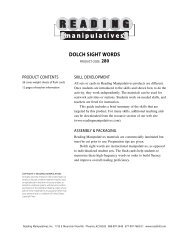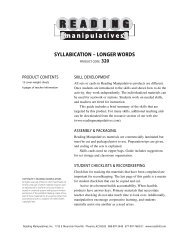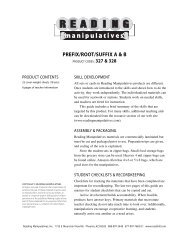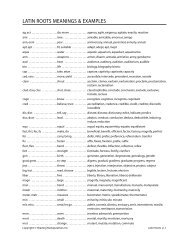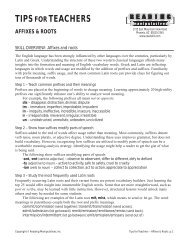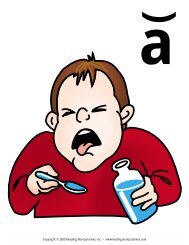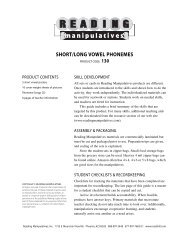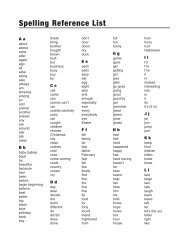compound words a & b - Reading Manipulatives
compound words a & b - Reading Manipulatives
compound words a & b - Reading Manipulatives
You also want an ePaper? Increase the reach of your titles
YUMPU automatically turns print PDFs into web optimized ePapers that Google loves.
COMPOUND WORDS A & BPRODUCT CODES: 430 & 435CW CENTERED A & BPRODUCT CODES: 445 & 450PRODUCT CONTENTS16 cover-weight sheets (level A)24 cover-weight sheets (level B)8 pages of teacher informationSKILL DEVELOPMENTAll sets or cards in <strong>Reading</strong> <strong>Manipulatives</strong> products are different.Once students are introduced to the skills and shown how to do theactivity, they work independently. The individualized materials canbe used for seatwork or stations. Students work on needed skills,and teachers are freed for instruction.This guide includes a brief summary of the skills that aretargeted by this product. For many skills, additional teaching aidscan be downloaded from the resource section of our web site(www.readingmanipulatives.com).ASSEMBLY & PACKAGING<strong>Reading</strong> <strong>Manipulatives</strong> materials are commercially laminated butmust be cut and packaged prior to use. Preparation tips are given,and coding of the sets is explained.Store the student sets in zipper bags. Small food storage bagsfrom the grocery store can be used. Heavier 4 mil zipper bags canbe found online. Amazon often has 4 x 6 or 5 x 8 bags, which aregood sizes for the manipulatives.COPYRIGHT © READING MANIPULATIVESAll rights reserved. Printed in the United States ofAmerica. No part of these materials may be usedor reproduced in any form or by any means, orstored in a retrieval system, without prior writtenpermission of the publisher. Making copies of anypart of these materials for any purpose other thanyour personal use is a violation of United Statescopyright laws.STUDENT CHECKLISTS & RECORDKEEPINGChecklists for tracking the materials that have been completed areimportant for recordkeeping. The last four pages of this guide aremasters for student checklists that can be copied and cut.Active involvement builds accountability. When feasible,products have answer keys. Primary materials that necessitateteacher checking do not take much time to look over. Additionally,manipulatives encourage cooperative learning, and studentsnaturally assist one another as a need arises.<strong>Reading</strong> <strong>Manipulatives</strong>, Inc. 1725 E. Mountain View Rd. Phoenix, AZ 85020 888-997-2448 877-997-7685 (F) www.readskill.com
VOCABULARYVocabulary, or the repertoire of <strong>words</strong> that an individual knows and uses to communicate, is a keycomponent of effective reading from the earliest stages. Consider a young student doing a phonicsexercise. If the child blends the letters correctly, but is not familiar with the word (/t/ /a/ /n/ = tan), thenthe word is not recognized. Beginning readers have more success when reading <strong>words</strong> that are part oftheir oral vocabularies. Those with limited vocabularies struggle with phonics and other reading tasks.Vocabulary is also central to comprehension. Students cannot understand what they are reading ifthey do not know what the <strong>words</strong> mean. Additionally, comprehension degrades proportionally tounknown vocabulary.Most <strong>words</strong> are learned indirectly, or through everyday language experiences. Humans learn <strong>words</strong>as they communicate. Interactions with adults are the best way for children to expand their vocabularies.Through sharing of events and books, adults provide knowledge and stimuli that children need. Onceindividuals are fluent readers, books and other types of written communication are optimal for expandingvocabulary and concepts.Since experience is the most critical factor in the development of concepts and vocabulary, childrenwho come from environments rich in language and stimulation fare better in school. Their backgroundsimprove their ability to communicate, conceptualize, think abstractly, and categorize. But for many oftoday’s students, educators must provide more language foundation than in the past.Despite the fact that most vocabulary is acquired indirectly, research suggests that vocabulary canbe improved with explicit instruction. Word-development strategies are applicable to all types ofvocabulary: listening, speaking, reading, and writing.Direct instruction helps students to learn <strong>words</strong> that have not been mastered from life experiences.It can be provided through oral discussion that familiarizes students with vocabulary <strong>words</strong>. Often oralword instruction is offered before a story or text lesson is read. These introductory vocabulary lessonsalso aid comprehension. The discourse teaches the <strong>words</strong> and lays groundwork for the content that is tobe covered. If students are to remember the <strong>words</strong> and make them part of their working vocabularies,they need repeated exposure and additional practice using the <strong>words</strong> over an extended period of time.Obviously teachers cannot teach students all the <strong>words</strong> they do not know, so students must learnhow to proceed when they encounter unknown <strong>words</strong>. They can be taught strategies for dealing withdifficult vocabulary <strong>words</strong>. Often context can provide clues to help students determine the meaning of aword. They can also use affixes and roots to analyze <strong>words</strong> to ascertain meaning. Of course, dictionariesor other reference materials can provide definitions, but due to time involved in looking up unknown<strong>words</strong>, students are less likely to use these.Finally, direct instruction can expand general word knowledge. Lessons can teach students both<strong>words</strong> and specific strategies. Ambiguities of the English language make learning <strong>words</strong> a challenge.Multiple meanings, spellings, and pronunciations confuse students and can hinder verbal or writtencommunication. Students need to develop awareness of synonyms, antonyms, homonyms, andheteronyms. Direct instruction is necessary if students are to master these concepts and relatedvocabulary <strong>words</strong>.<strong>Reading</strong> <strong>Manipulatives</strong> vocabulary products build word knowledge with intuitive, holisticmanipulatives and include cloze sentences to assure that students use <strong>words</strong> properly in context.Students learn to utilize prefixes, suffixes, and Latin root <strong>words</strong> as meaning-analysis devices.Synonym substitution, a powerful writing strategy, is taught, as well as <strong>compound</strong> <strong>words</strong>. Word classand relationship analysis expand vocabulary and thinking skills, and analogy manipulatives teach theseconcepts. Multilevel materials can advance vocabulary in students of all ages and abilities. Hands-onapproaches are superb for expanding vocabulary and usage concepts.
USING COMPOUND WORDSEnglish <strong>words</strong>, especially nouns, are often joined to express a single item or idea. Compound WordMatch-Ups teach or review many <strong>compound</strong> <strong>words</strong> and familiarize students with these formations.Level A contains 224 <strong>compound</strong>s; level B covers 336 <strong>compound</strong>s. A downloadable resource list on ourweb site has more than 800 <strong>compound</strong> <strong>words</strong> with vocabulary difficulty level noted.Most students are naturally curious about language. As they match the pairs, they recollect familiarand not so familiar <strong>words</strong>. They learn new vocabulary and concepts as they figure out the combinations.Students also develop divergent thinking skills since they might need to come up with alternate<strong>compound</strong> <strong>words</strong> in order to get all the cards to match. As they complete more sets, there is markedimprovement in their methodology.Finally, students enjoy this puzzle-like activity. No matter how many sets they complete, they comeback for more. Compound Words Match-Ups are ideal materials for them to work on if they have shortblocks of free time since the sets do not take long to complete.RIGHT & LEFT JUSTIFIED VS. CENTERED WORDSIf using the right and left justified sets, students should first sort the<strong>words</strong>. The first half of each <strong>compound</strong> is right justified and has thecode on the left. The second half is left justified and has the code onthe right. Once sorted, students should arrange all the first parts in avertical column. Then they take each second part and go down thecolumn until a match is found. Occasionally there is more than onepossibility. Since all cards must be matched, this leads students to thecorrect choice.Centering the <strong>words</strong> makes this a far more challenging activity.Instead of knowing the 14 beginnings and only having to match theendings, now students must deal with 28 <strong>words</strong> that can go in eitherposition. Students should simply arrange the <strong>words</strong> in lines orcolumns and begin to make matches.Once the activity is completed, the student uses the answer keyto check work and then records the completed set.beanblackpostcountnickdoorheartovergreenworrybagmail_officedownnamematbeatpasshousewartbook casecow boydown townevery bodyfinger printgrape fruitsun glassestea spoontool boxweek endCOMPOUND WORD FORMSMost <strong>compound</strong> <strong>words</strong> are closed into one word, but some remain separate <strong>words</strong> and some arehyphenated. All forms are included in the manipulatives and the resource list. As the list illustrates, thereare not many English <strong>compound</strong> <strong>words</strong> that are not joined. The few examples in the manipulatives havea hyphen or underline (to denote space) before the second word.air bag clip art hot dog high chair ice skate rubber band swimming pooldouble-cross get-together merry-go-round mother-in-law self-esteemHyphenated <strong>compound</strong> modifiers are discussed below. It is a common practice in English tocombine <strong>words</strong> to form modifiers.HYPHENATED COMPOUND MODIFIERSOften in English, two or more <strong>words</strong> are joined to form an adjective. These <strong>compound</strong> modifiers arehyphenated. The combinations vary and are not listed as <strong>compound</strong> <strong>words</strong> in dictionaries.best-loved poems snow-capped mountains good-looking man broken-down car
PREPARING & MANAGING MATERIALSCUTTING & PACKAGINGA rotary trimmer is ideal for cutting laminated materials.A paper cutter will suffice, but rotary trimmers are moreaccurate and easier to use. If your school does not have one,rotary trimmers can be purchased at art and office supplystores or at discount warehouse clubs. Large copy centersoften have a rotary trimmer available for customer use.Make the longest cuts on the trimmer. Then use scissorsto cut apart pieces on the strips. Sharp scissors expeditepreparation as long as cuts can be made with one motion.Store the student sets in zipper bags. Small food storagebags from the grocery store can be used. Heavier 4 milzipper bags can be found online. 4 x 6 bags will hold boththe manipulatives and the answer keys.Every piece in each product has a unique color or setcode that can be used to maintain set integrity. If a loosepiece is found, the code tells which product and set to returnit to. Set codes are also used for recordkeeping.CLASSROOM ORGANIZATIONSelect storage containers that hold and display the sets most efficiently. Those that offer high visibilityspeed the selection process. Many types and sizes of plastic storage boxes are available. Look at standardstorage tubs, as well as containers for food or office supplies.Since students will be choosing sets that they have not yet completed, classroom organization isimportant. If using multiple sets of manipulatives, it works best to spread them out in various locationsthroughout the classroom. That way, students will not have to congregate in a single area.CHECKLISTS & STUDENT ACCOUNTABILITYMake copies of the appropriate checklist that follows. Every <strong>Reading</strong> <strong>Manipulatives</strong> product containsunique, individualized activities. Students (or teachers) use the checklists to record work and to selectsets or cards that have not yet done. Since the manipulatives and cards are part of a comprehensiveinstructional program, it is imperative to track completed materials.Consider using student language arts folders as an organizational tool. Checklists can be glued to theinside folder, rather than leaving them loose. That way, they are easy to get at and unlikely to be lost.COMPOUND WORD ACTIVITY EXTENSIONSSets in Compound Word Match-Ups could be done repeatedly. Research suggests that <strong>words</strong> are notmastered without repeated exposure, with 4 being the average that is necessary. Students will not retainindividual vocabulary <strong>words</strong> unless they practice these <strong>words</strong> over time.Consider adding <strong>compound</strong> <strong>words</strong> to some weekly spelling lists. Students tend to focus on their list<strong>words</strong>, and immersion helps students remember the concepts. You can even select the <strong>compound</strong> <strong>words</strong>based on spelling characteristics (vowel sounds, Dolch <strong>words</strong>, etc.).Finally, encourage students to use <strong>compound</strong> <strong>words</strong> in their written communication. Extra creditcould be offered for writing some of the <strong>words</strong> from the Compound Words Match-Ups set in sentences.
COMPOUND WORDS — CWACOMPOUND WORDS — CWACWA-1________CWA-6________CWA-11 ________CWA-1________CWA-6________CWA-11 ________CWA-2________CWA-7________CWA-12 ________CWA-2________CWA-7________CWA-12 ________CWA-3________CWA-8________CWA-13 ________CWA-3________CWA-8________CWA-13 ________CWA-14 ________CWA-14 ________CWA-4________CWA-9________CWA-15 ________CWA-4________CWA-9________CWA-15 ________CWA-5________CWA-10 ________CWA-16 ________CWA-5________CWA-10 ________CWA-16 ________COMPOUND WORDS — CWACOMPOUND WORDS — CWACWA-1________CWA-6________CWA-11 ________CWA-1________CWA-6________CWA-11 ________CWA-2________CWA-7________CWA-12 ________CWA-2________CWA-7________CWA-12 ________CWA-3________CWA-8________CWA-13 ________CWA-3________CWA-8________CWA-13 ________CWA-14 ________CWA-14 ________CWA-4________CWA-9________CWA-15 ________CWA-4________CWA-9________CWA-15 ________CWA-5________CWA-10 ________CWA-16 ________CWA-5________CWA-10 ________CWA-16 ________COMPOUND WORDS — CWACOMPOUND WORDS — CWACWA-1________CWA-6________CWA-11 ________CWA-1________CWA-6________CWA-11 ________CWA-2________CWA-7________CWA-12 ________CWA-2________CWA-7________CWA-12 ________CWA-3________CWA-8________CWA-13 ________CWA-3________CWA-8________CWA-13 ________CWA-14 ________CWA-14 ________CWA-4________CWA-9________CWA-15 ________CWA-4________CWA-9________CWA-15 ________CWA-5________CWA-10 ________CWA-16 ________CWA-5________CWA-10 ________CWA-16 ________
COMPOUND WORDS — CWBCOMPOUND WORDS — CWBCWB-1_______CWB-9_______CWB-17 _______CWB-1_______CWB-9_______CWB-17 _______CWB-2_______CWB-10 _______CWB-18 _______CWB-2_______CWB-10 _______CWB-18 _______CWB-3_______CWB-11 _______CWB-19 _______CWB-3_______CWB-11 _______CWB-19 _______CWB-4_______CWB-12 _______CWB-20 _______CWB-4_______CWB-12 _______CWB-20 _______CWB-5_______CWB-13 _______CWB-21 _______CWB-5_______CWB-13 _______CWB-21 _______CWB-6_______CWB-14 _______CWB-22 _______CWB-6_______CWB-14 _______CWB-22 _______CWB-7_______CWB-15 _______CWB-23 _______CWB-7_______CWB-15 _______CWB-23 _______CWB-8_______CWB-16 _______CWB-24 _______CWB-8_______CWB-16 _______CWB-24 _______COMPOUND WORDS — CWBCOMPOUND WORDS — CWBCWB-1_______CWB-9_______CWB-17 _______CWB-1_______CWB-9_______CWB-17 _______CWB-2_______CWB-10 _______CWB-18 _______CWB-2_______CWB-10 _______CWB-18 _______CWB-3_______CWB-11 _______CWB-19 _______CWB-3_______CWB-11 _______CWB-19 _______CWB-4_______CWB-12 _______CWB-20 _______CWB-4_______CWB-12 _______CWB-20 _______CWB-5_______CWB-13 _______CWB-21 _______CWB-5_______CWB-13 _______CWB-21 _______CWB-6_______CWB-14 _______CWB-22 _______CWB-6_______CWB-14 _______CWB-22 _______CWB-7_______CWB-15 _______CWB-23 _______CWB-7_______CWB-15 _______CWB-23 _______CWB-8_______CWB-16 _______CWB-24 _______CWB-8_______CWB-16 _______CWB-24 _______
COMPOUND WORDS CENTERED — CWACOMPOUND WORDS CENTERED — CWACWA-1________CWA-6________CWA-11 ________CWA-1________CWA-6________CWA-11 ________CWA-2________CWA-7________CWA-12 ________CWA-2________CWA-7________CWA-12 ________CWA-3________CWA-8________CWA-13 ________CWA-3________CWA-8________CWA-13 ________CWA-14 ________CWA-14 ________CWA-4________CWA-9________CWA-15 ________CWA-4________CWA-9________CWA-15 ________CWA-5________CWA-10 ________CWA-16 ________CWA-5________CWA-10 ________CWA-16 ________COMPOUND WORDS CENTERED — CWACOMPOUND WORDS CENTERED — CWACWA-1________CWA-6________CWA-11 ________CWA-1________CWA-6________CWA-11 ________CWA-2________CWA-7________CWA-12 ________CWA-2________CWA-7________CWA-12 ________CWA-3________CWA-8________CWA-13 ________CWA-3________CWA-8________CWA-13 ________CWA-14 ________CWA-14 ________CWA-4________CWA-9________CWA-15 ________CWA-4________CWA-9________CWA-15 ________CWA-5________CWA-10 ________CWA-16 ________CWA-5________CWA-10 ________CWA-16 ________COMPOUND WORDS CENTERED — CWACOMPOUND WORDS CENTERED — CWACWA-1________CWA-6________CWA-11 ________CWA-1________CWA-6________CWA-11 ________CWA-2________CWA-7________CWA-12 ________CWA-2________CWA-7________CWA-12 ________CWA-3________CWA-8________CWA-13 ________CWA-3________CWA-8________CWA-13 ________CWA-14 ________CWA-14 ________CWA-4________CWA-9________CWA-15 ________CWA-4________CWA-9________CWA-15 ________CWA-5________CWA-10 ________CWA-16 ________CWA-5________CWA-10 ________CWA-16 ________
COMPOUND WORDS CENTERED — CWBCOMPOUND WORDS CENTERED — CWBCWB-1_______CWB-9_______CWB-17 _______CWB-1_______CWB-9_______CWB-17 _______CWB-2_______CWB-10 _______CWB-18 _______CWB-2_______CWB-10 _______CWB-18 _______CWB-3_______CWB-11 _______CWB-19 _______CWB-3_______CWB-11 _______CWB-19 _______CWB-4_______CWB-12 _______CWB-20 _______CWB-4_______CWB-12 _______CWB-20 _______CWB-5_______CWB-13 _______CWB-21 _______CWB-5_______CWB-13 _______CWB-21 _______CWB-6_______CWB-14 _______CWB-22 _______CWB-6_______CWB-14 _______CWB-22 _______CWB-7_______CWB-15 _______CWB-23 _______CWB-7_______CWB-15 _______CWB-23 _______CWB-8_______CWB-16 _______CWB-24 _______CWB-8_______CWB-16 _______CWB-24 _______COMPOUND WORDS CENTERED — CWBCOMPOUND WORDS CENTERED — CWBCWB-1_______CWB-9_______CWB-17 _______CWB-1_______CWB-9_______CWB-17 _______CWB-2_______CWB-10 _______CWB-18 _______CWB-2_______CWB-10 _______CWB-18 _______CWB-3_______CWB-11 _______CWB-19 _______CWB-3_______CWB-11 _______CWB-19 _______CWB-4_______CWB-12 _______CWB-20 _______CWB-4_______CWB-12 _______CWB-20 _______CWB-5_______CWB-13 _______CWB-21 _______CWB-5_______CWB-13 _______CWB-21 _______CWB-6_______CWB-14 _______CWB-22 _______CWB-6_______CWB-14 _______CWB-22 _______CWB-7_______CWB-15 _______CWB-23 _______CWB-7_______CWB-15 _______CWB-23 _______CWB-8_______CWB-16 _______CWB-24 _______CWB-8_______CWB-16 _______CWB-24 _______



